Comments from the Chair, Robert W. Hastings:
My wife and I had an excellent visit to San Francisco for the national Sierra Club Awards Ceremony on September 12. It was good to visit with club leaders and old friends at this annual event. Awards were given to an outstanding group of Club and environmental activists, and it was a great honor to be included in this group. The Sierra Club continues to be one of the strongest and most effective environmental organizations and we can all be proud to be members. I look forward to seeing many of you at our Chapter Retreat on October 23-25.
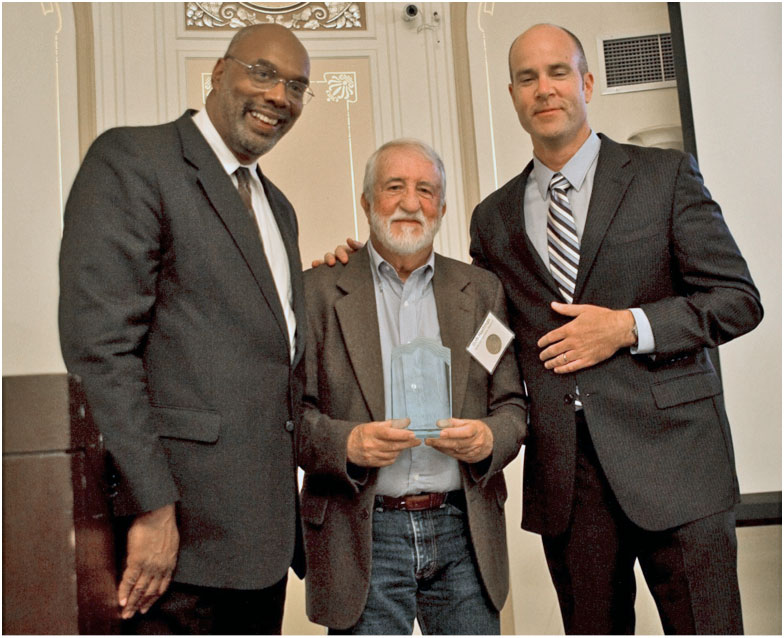
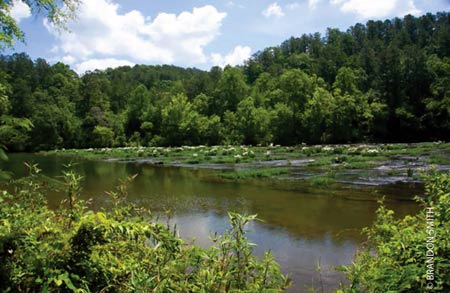 Save the Date! October 23-25, 2015
Save the Date! October 23-25, 2015
Alabama Sierra Club Retreat
Explore, Enjoy, Protect… on 440 acres at the beautiful Living River Center on the Cahaba River. The focus will be on outings with experienced guides, hands-on learning, and exploring the beauty of the river and surrounding area. There will be opportunities to hike, bird, hunt for fossils, and canoe the Cahaba. Lodging at the retreat center will be camp style dorms with bunk beds. You will need to bring your linens and blanket or sleeping bag, plus a pillow and towel.
Lodging and meals will be available on site. Download Registration Form Here.
2015 National Sierra Club Special Service Award – Robert W. Hastings
Alabama Chapter Chair Bob Hastings was given a Special Service Award by the National Sierra Club at the annual meeting in San Francisco, September 12, 2015. The following is a condensed version of the statement submitted in support of his nomination:
Robert W. (Bob) Hastings first joined the Sierra Club in 1982, while living in New Jersey. With the New Jersey Chapter, he lobbied for protection of threatened and endangered species, and for establishment of the Pinelands Preserve. As a zoologist at Rutgers University for 12 years, and throughout his 30-year career as a marine biologist, he was thoroughly committed to environmental protection, and his service to the Sierra Club continuously merged with his professional responsibilities.
Shortly after moving to Louisiana in 1984 to become Director of the Turtle Cove Environmental Research Station on Lake Pontchartrain, and a faculty member at Southeastern Louisiana University, Bob begin a long association with the Delta Chapter, and the Chappapeela-Honey Island Group. He was to serve as an Executive Committee member and in other leadership positions (including Chair) of both Group and Chapter.
Bob participated in the formation of a new organization to address environmental problems of the Gulf of Mexico in 1994, the Gulf Restoration Network (or GRN). He was to become a Board member in 1998 (continuing up until the present), and served as Board Chair in 2007-2012.
A major campaign of the Delta Chapter at this time was the restoration of Lake Pontchartrain water quality. Bob’s research on Lake Pontchartrain and surrounding areas merged with the Sierra Club campaign, and he frequently gave talks on this research at Sierra Club meetings. Eventually he was to publish a book based upon his research, “The Lakes of Pontchartrain: Their History and Environments” (University Press of Mississippi, 2009).
B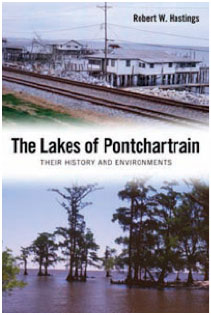 ob also became a volunteer with the New Orleans Sierra Club Inner City Outings program, and hosted overnight outings to Turtle Cove (Figure 1), as well as a weeklong trip to Big South Fork National River and Recreation Area in Tennessee. Children from the Gerttown Community Center and the Pediatric AIDS Program who came to Turtle Cove on ICO outings were able to fish, swim, and canoe, as well as play environmental games. Initially, many were quite fearful of the “wild” swamp environment, but soon became comfortable with these new surroundings, and enjoyed their experiences at Turtle Cove.
ob also became a volunteer with the New Orleans Sierra Club Inner City Outings program, and hosted overnight outings to Turtle Cove (Figure 1), as well as a weeklong trip to Big South Fork National River and Recreation Area in Tennessee. Children from the Gerttown Community Center and the Pediatric AIDS Program who came to Turtle Cove on ICO outings were able to fish, swim, and canoe, as well as play environmental games. Initially, many were quite fearful of the “wild” swamp environment, but soon became comfortable with these new surroundings, and enjoyed their experiences at Turtle Cove.
Because of his dedication to environmental education and programs developed at Turtle Cove, Bob was given numerous awards in recognition of this service. These included Conservation Educator of the Year (1993) - Governor's Conservation Achievement Award presented by Louisiana Wildlife Federation, February, 1994; Coastal Stewardship Award for Education (1997) - presented by Coalition to Restore Coastal Louisiana; Award for Excellence in Environmental Education (1998) – presented by U.S. Environmental Protection Agency Region 6; and National Wetlands Award in Education/Outreach, May, 2002 (sponsored by the Environmental Law Institute, U. S. Environmental Protection Agency, U. S. Natural Resources Conservation Service, U. S. Forest Service, and National Marine Fisheries Service).
Bob resigned from Southeastern Louisiana University in 2001 and moved to Alabama in January, 2002, to become Director of the Alabama Natural Heritage Program, working to protect threatened and endangered species. He again became active in the Sierra Club, in both the Montgomery Group and the Alabama Chapter, and continued his commitment to environmental protection. He was elected to the Alabama Chapter Executive Committee in 2003, has continued to serve up until the present, and now serves as Chair (in 2014-2015).
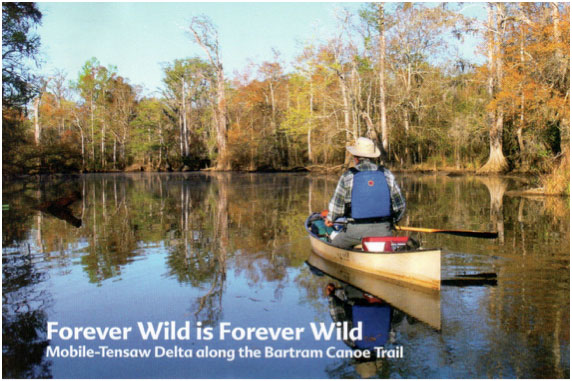
Bob canoeing for Forever Wild.
In January, 2013, Bob and other Chapter leaders helped organize a Chapter-National Joint Planning Workshop, with participation from National Board members. This two-day planning workshop resulted in the development of the Chapter’s Water Campaign. In cooperation with the Alabama Rivers Alliance, Bob and other Chapter leaders helped to organize and sponsor a series of conferences throughout the state in 2013 and 2014 to publicize the need for a comprehensive Water Management Plan for Alabama, and to guide the development of that plan to protect the state’s natural waters. Bob has also been nominated to serve on the focus panels to evaluate the various aspects of the proposed plan. Other recent Alabama Chapter campaigns, have included protests of fracking on public lands, renewing the Forever Wild program, and protecting existing State public lands.
Bob has also been active at the National Sierra Club level. He attended the Sierra Club Summit in San Francisco in September, 2005. He served on the National Sierra Club Environmental Quality Strategy Team from 2005-2008, and also served as the EQST liaison to the Sierra Club Environmental Justice Committee. He participated in the National Sierra Club Diversity 101 Coaches Conclave sessions in San Francisco, April 1-2, 2011, and in Washington, D.C., June 2-3, 2011.
Bob has also been active in other environmental organizations in recent years. He has served on the Alabama Wildlife Federation Editorial Board since 2006, and has written several articles for the AWF magazine, Alabama Wildlife. He has also been active in an organization to protect a local paddling stream, the Autauga Creek Improvement Committee, and served as an instructor for River Kids Kayak Classes, which have trained over 100 local kids how to paddle and stay safe.
Throughout these years as a Sierra Club member, Bob has continued to make public presentations for various schools, camps, civic organizations, and universities, as well as Sierra Club Groups and Chapters, on a variety of topics including biodiversity, threatened and endangered species, Gulf of Mexico oil spill, Sierra Club energy policy, and snakes (and other reptiles) of the Southeast. In addition, he has written numerous letters to the editor and to political leaders, and given media interviews on environmental issues. After his retirement in 2005, he formalized his mission to educate young people (as well as adults) that snakes are not bad animals as “Dr. Bob’s Traveling Snake Show” (see www.drbobssnakes.com).See the complete nomination information here.
8th annual Wild & Scenic Film Festival in Birmingham at the Avon Theatre on October 22
The Alabama Rivers Alliance and Alabama Environmental Council are pleased to present the 8th annual Wild & Scenic Film Festival in Birmingham at the Avon Theatre on October 22.
What is the Wild & Scenic Film Festival? Glad you asked! The Wild & Scenic Film Festival is the largest environmental film festival in the United States. It sits apart from the hundreds of festivals around the world by leaving you feeling INSPIRED and MOTIVATED to go out and make a difference in your community and the world.
It’s a festival for activists by activists. Thanks to funding from national partners, the festival goes on tour across America to reach audiences across the country. It is hosted in Alabama by the Alabama Rivers Alliance and the Alabama Environmental Council.
What kinds of films are shown at the Wild & Scenic Film Festival?
At the festival, you’ll LEARN new ideas from a selection of inspiring environmental films with hardhitting topics including bioengineering, water issues, wilderness preservation, citizen activism, and more. You’ll EXPERIENCE the adrenaline of kayaking the wildest rivers, climbing the highest peaks, and trekking across the globe with adventure films from around the world. You’ll EXPLORE the issues and movements with leading environmental activists and professionals, filmmakers, and celebrities. And you’ll CELEBRATE the natural and wild world.
This year, in addition to our selection of award-winning films from the national Wild & Scenic Film Festival about nature, community activism, conservation, water, wildlife and so much more, we will also feature local films from the Southern Exposure film fellowship program. We are very excited to feature a panel of experts on-hand to address any questions raised from the films, or to learn more about the issues concerning our communities. We expect the Q&A to be a true highlight of the festival as we can dive even deeper into the important challenges and solutions featured in the showcase of films.
For more details, please visit http://www.alabamarivers.org/events/wildandscenic
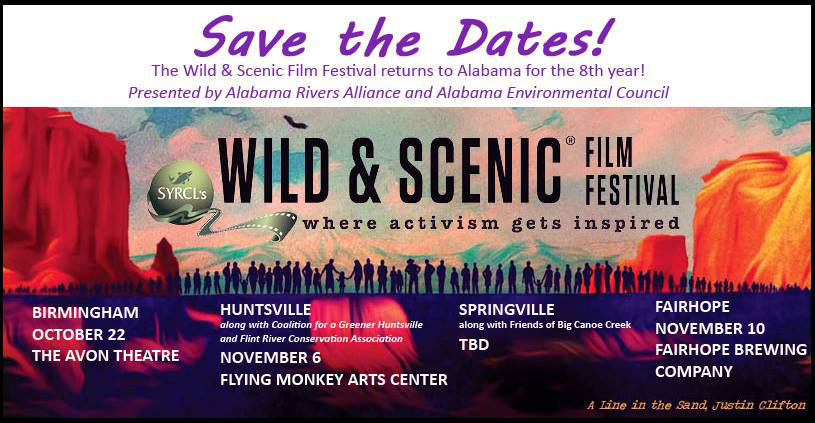
2015 Regional Food & Farm Forums
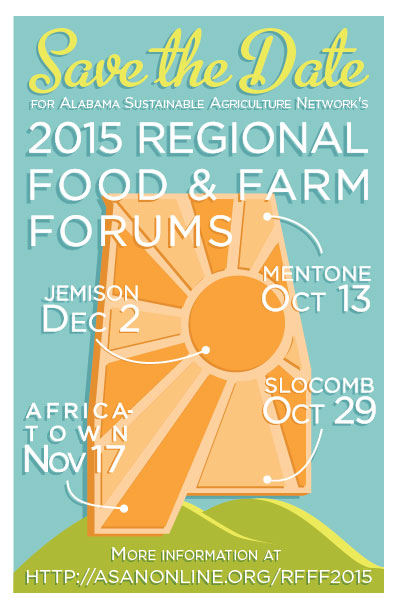 Mentone Forum will be 10/13, with times as follows: 9:30-10:00 registration, event 10:00-6:30pm. That includes a farm tour, mini-workshops, lunch (brown bag or order one for extra), roundtable discussions, and dinner (provided as part of registration cost). It's going to be at the Farm at Windy Hill in Mentone.
Mentone Forum will be 10/13, with times as follows: 9:30-10:00 registration, event 10:00-6:30pm. That includes a farm tour, mini-workshops, lunch (brown bag or order one for extra), roundtable discussions, and dinner (provided as part of registration cost). It's going to be at the Farm at Windy Hill in Mentone.
The Slocomb Forum (10/29) times aren't finalized, but tentatively registration will be 12:30-1:00 and it will go until 7:15. It will start with roundtable discussions, then a tour of the Working Cows Dairy (only certified organic dairy in Alabama), then dinner.
Africatown (11/17) will tentatively be from 1:00-7:30, with registration from 12:30-1:00, then a tour of the community and community garden, then an oral historytelling with Africatown community members, then roundtable discussions and dinner.
Jemison (12/2) TBD.
8 Birding Trail Sites Perfect for Fall
Fall migration is getting into full swing. There are many locations throughout Alabama that are genuine hotspots to watch as our feathered friends head south for winter. With 270 sites along all 8 of Alabama Birding Trails, what locations should you pick? While there are many more locations that you might find amazing, here are just a few favorites from the Alabama Birding Trails program.
PROCEDURE FOR SENDING MATERIAL TO THE ALABAMA SIERRAN
Many thanks to Roe Hyche, Bob Hastings, Lucina Horner, and Peggie Griffin for agreeing to be the new newsletter committee.
The newsletter is put together monthly, and material for the newsletter should be sent to plgriffin@comcast.net, with a subject line of "For the Editorial Board" no later than the 15th of the month.
Group newsletter editors may continue sending group meeting information and calendars of events to Joe Watts at joe@joewatts.com, no later than the 25th of each month.
Guidelines for Material:
The newsletter committee is seeking articles about Alabama environmental issues, articles highlighting Alabama’s special beautiful places, and engaging write-ups about group and chapter activities.
Articles should be originally written for the Alabama Sierran, factual, and timely.
A link to another publication should only be used rarely, but if a link is to be used, a full summary of the information (at least a paragraph long) should be written, with the link provided for more detailed information.
The newsletter committee has the right to make any changes, so that material will meet these guidelines.